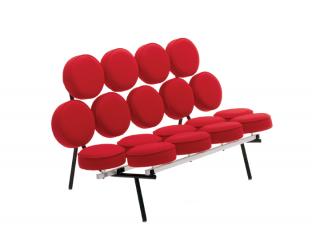If only all design “failures” were so successful. In the mid-1950s a plastics salesman approached George Nelson, director of design for the Herman Miller furniture company. The salesman was peddling inexpensive, molded 12-inch foam discs, so Nelson asked designer Irving Harper to develop a piece of furniture around the discs. Over one weekend Harper designed a sofa, playfully arranging 18 upholstered discs appearing to “float” on a 52-inch-long metal frame.
The salesman’s cushions proved impractical, but the designers were intrigued by Harper’s whimsical creation. Even though making and covering the sofa’s individual seat pads took considerable time and proved to be costly, Herman Miller moved the piece into production in 1956. The company’s catalog offered the sofa for $452 and took pains to explain that “despite its astonishing appearance, this piece is very comfortable.” The discs were covered in vinyl, leather or fabric in bright colors; a buyer could even order mix-and-match cushion colors. In spite of the fact the marshmallow sofa turned heads, fewer than 200 were made between 1956 and 1965, when it was dropped from the Herman Miller line.
The sofa’s atom-like appearance is a precursor to the aesthetic style of the pop art of the 1960s. Many mid-century designs fell out of fashion by the late 1960s, but in the 1980s, interest began to return. Herman Miller returned the marshmallow sofa to production in the 1990s, and today consumers can order the sofa that “brightens a room” in 12 colors. And you can still mix-and-match the seat cushions.
In a 2009 interview, Frank Maraschiello of the renowned auction house Bonhams called the marshmallow sofa “one of the most whimsical designs ever to become an icon of American design.” Collectors agree; a green naugahyde version of the original sofa sold for $17,500 in 2015. Indeed, several top museums including the High Museum of Art in Atlanta, the Philadelphia Museum of Art and Denver’s Kirkland Museum of Fine & Decorative Art include marshmallow sofas in their collections, making it a functional piece of artwork for the home.





